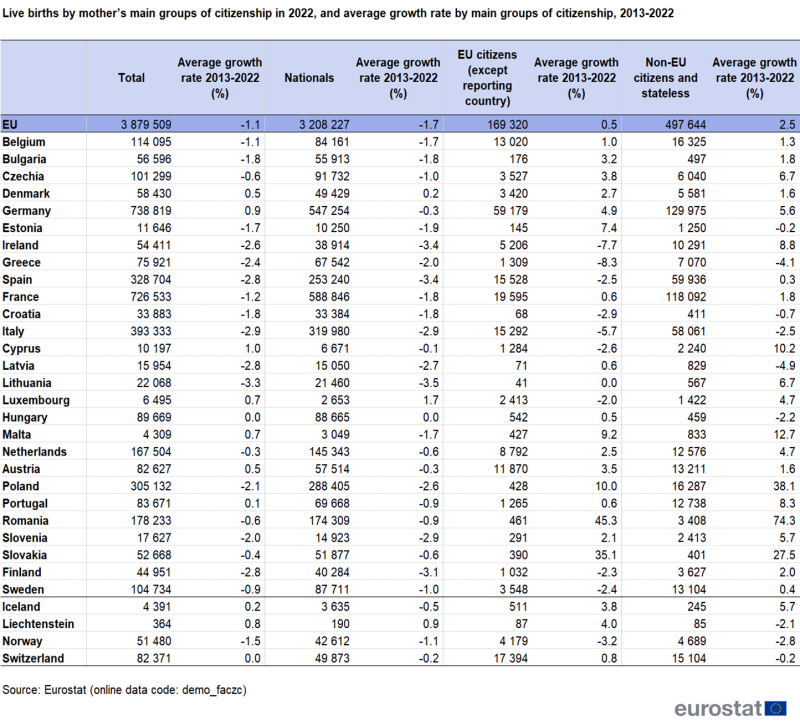Children in migration - demography and migration
Data extracted on 14 June 2024
Planned article update: June 2025
Highlights
On 1 January 2023, around 7.4 million children aged less than 18 years did not have the citizenship of their country of residence in the EU.
In 2022, 915 000 non-EU citizen and stateless children aged less than 15 years immigrated to one of the EU countries, more than tripling the number recorded in 2021.
In 2022, 12.8 % of newborns (498 000 births) in the EU had a mother who was not an EU citizen.
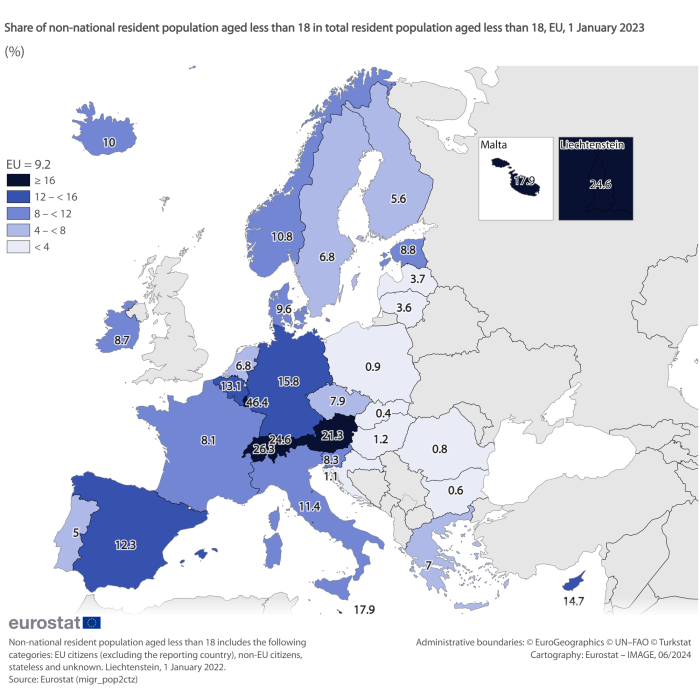
(%)
Source: Eurostat (migr_pop2ctz)
This article presents European statistics on children in migration based on international migration flows, the number of national and non-national citizens in the population (stocks) as well as data relating to live births by mother’s citizenship and the acquisition of citizenship. It focuses mainly on children arriving in or residing in an EU country different from their country of citizenship, encompassing both intra-EU migration and immigration from non-EU countries.
Migration of children depends mainly on the migration of their parents or relatives, although it also includes unaccompanied minors. The main explanatory factors of migration can be found in the combination of economic, environmental, political and social factors: either in a migrant's country of origin (push factors) or in the country of destination (pull factors).
This article forms part of the online publication Children in migration that also provides a range of complementary statistics on asylum applicants under the age of 18 and residence permits for family reasons issued to children.
Full article
Total number of non-national children in the EU: main indicators in 2023
On 1 January 2023, around 7.4 million children aged less than 18 years did not have the citizenship of their country of residence in the EU, accounting for 9.2 % of the total number of children living in the EU and 17.9 % of the total number of non-national residents (Figure 1). When looking at the distribution by main age groups, the highest weight was observed for the 5-9 years age group (30.1 %). In comparison, the share of children aged from 5 to 9 years in the total number of children in the EU aged less than 18 amounted to 27.8 %.
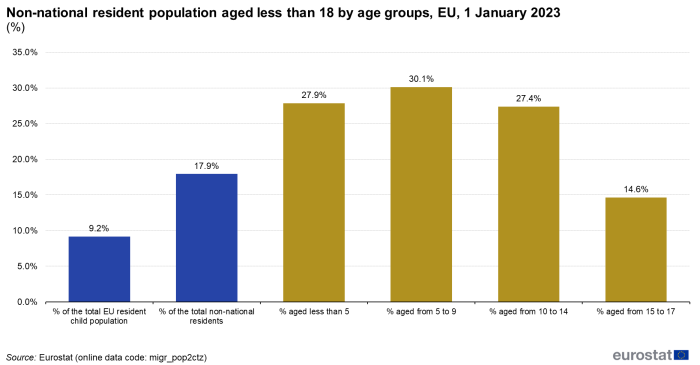
(%)
Source: Eurostat (migr_pop2ctz)
As shown in Figure 2, Germany (30.3 %), France (15.7 %), Italy (13.9 %) and Spain (13.4 %) were the main EU countries hosting non-national children – almost three out of four children without the citizenship of their country of residence were residing in one of those four EU countries.

(%)
Source: Eurostat (migr_pop2ctz)
In relative terms, the highest shares of non-national children in the total child population were observed in Luxembourg (46.4 %), Austria (21.3 %), Malta (17.9 %) and Germany (15.8 %) (Figure 3). The shares were also higher than 10 % in Cyprus, Belgium, Spain, and Italy. The lowest shares were observed in Slovakia (0.4 %) and Bulgaria (0.6 %).

(%)
Source: Eurostat (migr_pop2ctz)
The share of non-national children in the total non-national population (Figure 4) depends on past migration flows, on the number of births of non-national children on the territory of the host country and on policies regarding the acquisition of citizenship. This share is equal or higher than the EU average (17.9 %) in nine EU countries, with the value higher than 20 % in France (20.7 %) and Italy (20.1 %), while it is the lowest in Latvia (5.1 %) and Slovakia (6.2 %).
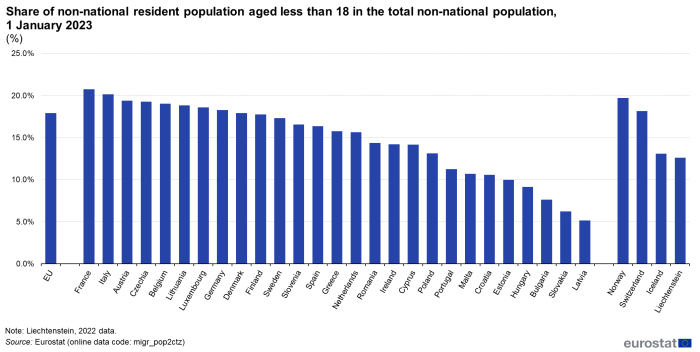
(%)
Source: Eurostat (migr_pop2ctz)
The breakdown by age group varies from one EU country to another (Table 1). For example, the share of children aged less than 5 years is higher than 30 % in Malta, Sweden, France, Lithuania and Denmark, and lower than 20 % in Portugal, Slovakia, Latvia and Bulgaria.
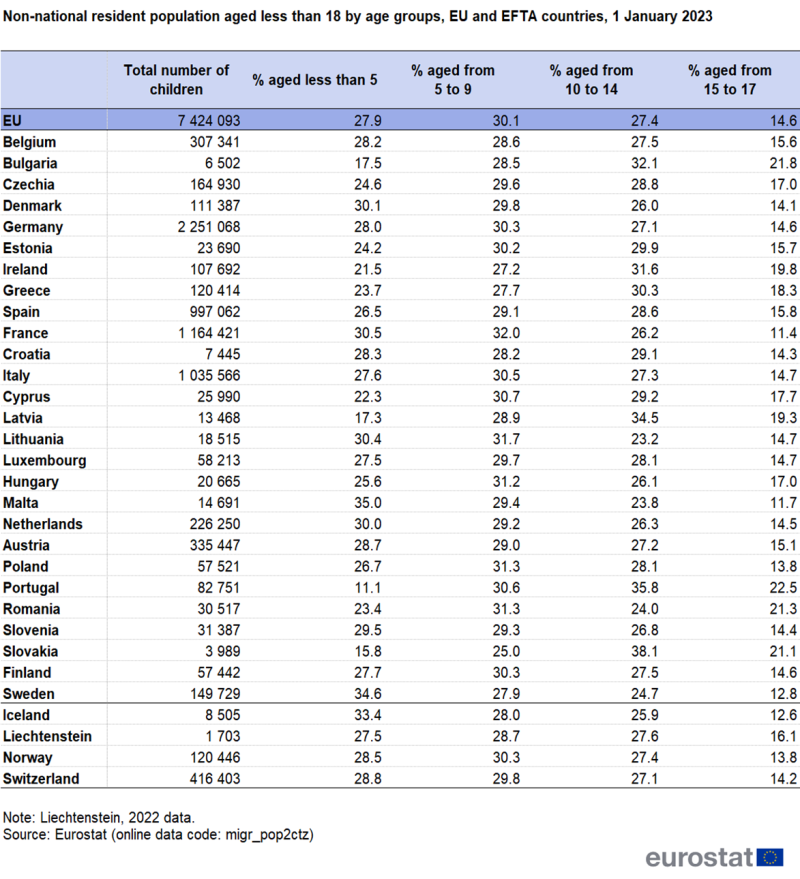
Source: Eurostat (migr_pop2ctz)
Non-national children in the EU: development over 2014-2023
Figure 5 shows the contribution of non-national children on the development of the total child population in the EU. This dynamic, as already stated, is influenced by several factors: emigration and immigration flows, acquisition of citizenship, birth of non-national children, and the fact that each year, some of the children become adults. The increase (+52.6 %) of the population of non-national children between 1 January 2014 and 1 January 2023, nearly offset the decrease in the population of national children (-4.4 %). This resulted in an almost stable total child population (-1.0 %).

(at 1 January, 2014=100)
Source: Eurostat (migr_pop2ctz)
These opposing trends in the populations of non-national and national children led to a significant increase in the weight of the population of non-national children in the total child population in the EU, from 6.0 % in 2014 to 9.2 % in 2023 (Figure 6).
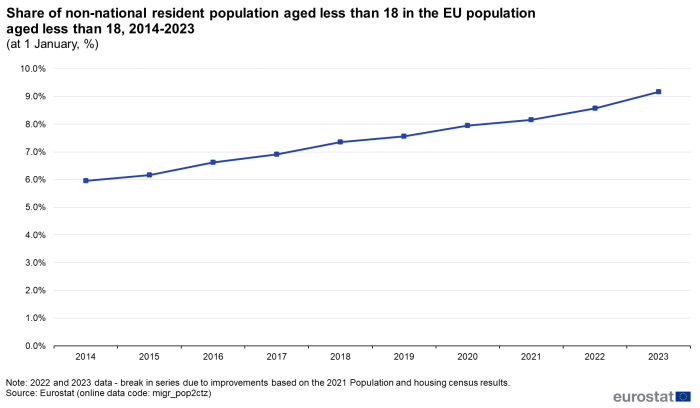
(at 1 January, %)
Source: Eurostat (migr_pop2ctz)
Number of children aged less than 15 years in the EU by main groups of citizenship
From this paragraph onwards, the statistics provided before 2021 for the category EU citizens (excluding reporting country) include the citizens of the United Kingdom, while the statistics provided before 2021 for the category non-EU citizens exclude the citizens of the United Kingdom. This break in the presented time series implies that the data from 2021 onwards are not fully comparable with the data prior to 2021.
Figure 7 presents the trend in the number of children aged less than 15 years in the EU having either an EU citizenship different from the EU country where they reside or a non-EU citizenship (including stateless). In both cases, an upward trend is visible from 2014 to 2023, but the total growth of non-EU citizen children (+63.9 %) was notably higher than for EU citizen children (+34.9 %). On 1 January 2023, the number of non-EU citizen children was more than twice (2.5) the number of EU citizen children.
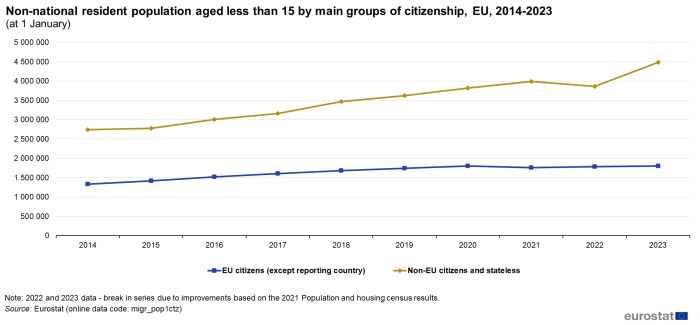
(at 1 January)
Source: Eurostat (migr_pop1ctz)
On 1 January 2023, over 70 % non-national children aged less than 15 years were non-EU citizens or stateless. Table 2, which provides a breakdown by main group of citizenship for EU and EFTA countries, shows that this structure can vary greatly from one country to another. In four EU countries (Belgium, Cyprus, Luxembourg and Slovakia), the majority of non-national children were EU citizens living in a country different from their country of citizenship, followed by three countries (Ireland, Austria and the Netherlands) where the share of EU children in the total number of non-national children was higher than 40 %. By contrast, in seven EU countries (Lithuania, Latvia, Slovenia, Romania, Poland, Greece and Estonia) this share was lower than 10 %.
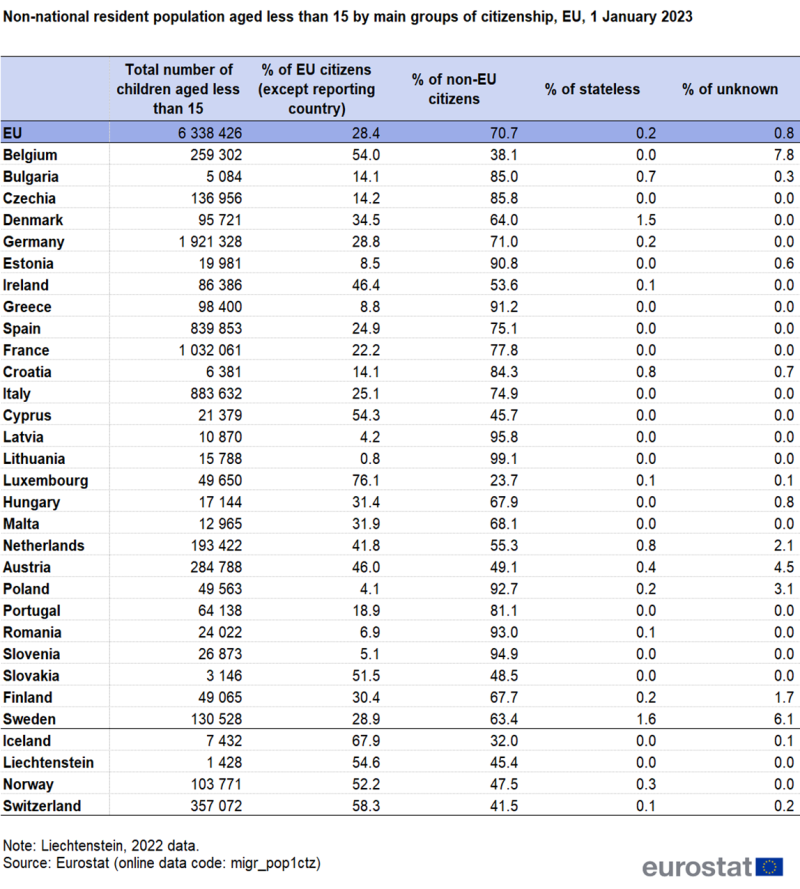
Source: Eurostat (migr_pop1ctz)
Table 3 presents the corresponding share of children aged less than 15 years in the total population for each main group of citizenship on 1 January 2023. At EU level, 14.8 % of the national residents were aged less than 15 years, whereas 15.3 % of non-national residents were aged less than 15 years. The Table also presents the share of children in the non-national population by main group of citizenship: 12.9 % for non-nationals with EU citizenship, 16.4 % for non-EU citizens, 22.9 % for stateless and 56.0 % for those with unknown citizenship. It indicates that the proportion of children in the migrant population depends on various groups of citizenship and not the same pattern is shared by all EU countries. The share of children in the population of nationals is for example higher than the one for non-nationals in 20 EU countries (in particular in Latvia, Slovakia, Estonia and Ireland), while the share of children in the non-national population with EU citizenship is higher than that for non-EU citizen children in only four EU countries (Latvia, Cyprus, Malta and Ireland). At the same time, the pattern observed at EU level could be found in Germany, France, Spain, Italy, Lithuania, Austria and Finland.
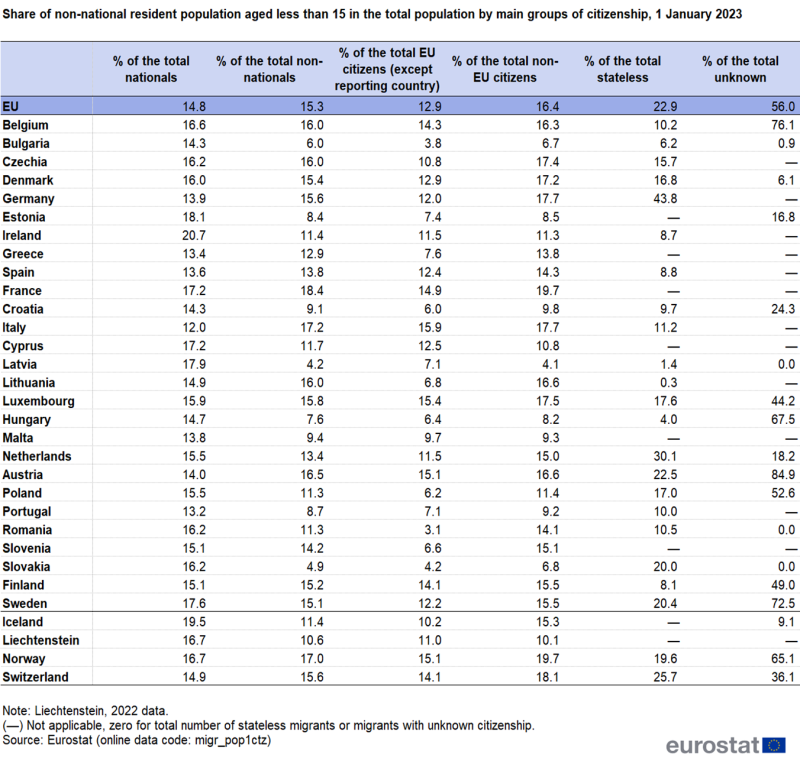
Source: Eurostat (migr_pop1ctz)
Table 4 provides some indicators on the trend in the resident population of non-national children aged less than 15 years in the EU and EFTA countries over 2014-2023. Among the nine EU countries where the share of non-nationals in the child population aged less than 15 years is higher than 10 %, this share decreased only in Luxembourg (-0.6 percentage points (pp)). By contrast, it increased slightly in Italy (+0.8 pp) and Cyprus (+0.5 pp), whereas the increase was the most rapid in Malta (+14.0 pp) and Germany (+10.4 pp). In both Malta and Germany, this increasing share of non-national children was mainly explained by the increasing share of non-EU citizen children.
When looking at the average yearly growth rates, the main feature at EU level involves the opposing trend followed by the number of national children (-0.6 %) and the number of non-national children (+4.9 %). In terms of geographical breakdown, the difference between EU and non-EU children is equal to 2.3 pp of growth on average per year (+3.4 % versus +5.6 %), but it corresponds in both cases to a significant growth. A positive growth rate in the number of national children can nevertheless be observed in eight of the EU countries, with the highest values recorded in Luxembourg (+1.5 %) and Sweden (+1.1 %). Negative growth rates for non-national children have been recorded in three EU countries (Italy, Slovakia and Greece). Over 2014-2023, positive yearly growth rates higher than 10 % for the total number of non-national children were observed in seven EU countries (Lithuania, Poland, Romania, Malta, Czechia, Germany and Slovenia), with a higher growth rate recorded for non-EU citizen children than EU citizen children in all those countries.
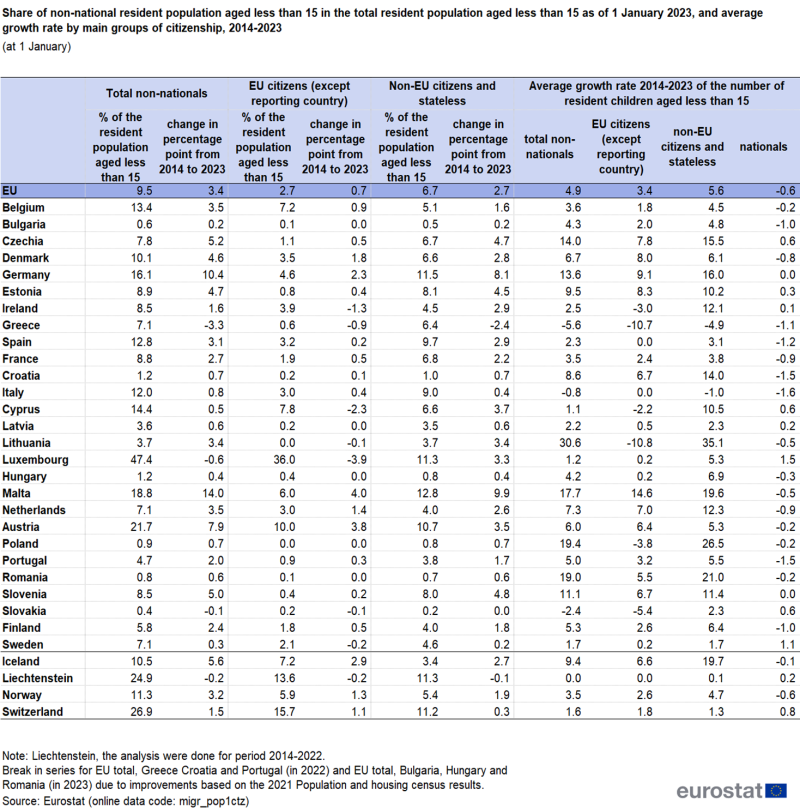
(at 1 January)
Source: Eurostat (migr_pop1ctz)
Immigration of children aged less than 15 years by main groups of citizenship
Immigration of children is one of the factors that influence the total number of non-national children in the total child population. In addition to EU citizen children living in an EU country different from their country of citizenship, and non-EU citizen (including stateless) children, immigration statistics also include national children having returned to their country of citizenship. Figure 8 shows the trend from 2013 to 2022 in the immigration of children in the EU for those three main groups of citizenship. It should be noted that the EU aggregated figures presented here do not represent the immigration flows to the EU from non-EU countries as they also include flows between different EU countries. Each group of citizenship followed a different path:
- The immigration of non-EU citizen and stateless children, which forms the main group over the whole period, peaked in 2015 linked to the 'migration crisis'. After peaking, it declined in the next 2 years, before increasing again in 2018 and 2019. During the COVID-19 pandemic in 2020, a drop was recorded, while in 2021 the number increased again. In 2022, 915 000 non-EU citizen and stateless children aged less than 15 years immigrated to one of the EU countries (highest value in the time series starting in 2013). This increase, more than tripling compared with 2021, can be partially explained by the change in immigration from Ukraine.
- The immigration of EU citizen children to an EU country different from their country of citizenship) is characterised by an upward trend between 2013 and 2015 and a downward trend from 2015 onwards, accentuated in 2020 during the COVID-19 pandemic (-14.8 %). Over the entire period, the immigration of EU citizen children decreased by 6.5 % to reach 112 496 persons in 2021.
- The immigration of national children exhibited an upward trend from 2013 to 2019, but as for EU and non-EU citizen children, a stronger decline in immigration of nationals was observed in 2020 during the COVID-19 pandemic. In 2021, 156 649 children returned to their EU country of citizenship, while in 2022 their number increased to 183 672.
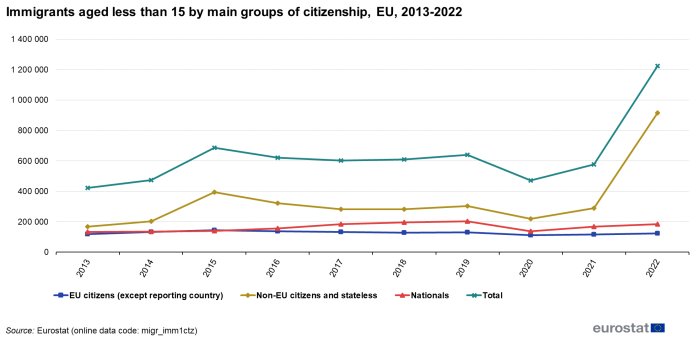
Source: Eurostat (migr_imm1ctz)
Table 5 provides the breakdown by main groups of citizenship for available EU and EFTA countries in 2022. At EU level, most immigrant children in the EU were non-EU citizens (74.7 % of all immigrant children in 2022). In six EU countries (Germany, Spain, France, Czechia, Italy and the Netherlands), the level of child immigration was higher than 50 000. In all those countries, the share of non-EU citizens and stateless immigrant children was over 50 %, with the highest value recorded for Czechia (97.4 %). By contrast, a share of nationals higher than 50 % of the total child immigration was observed in Slovakia, Bulgaria and Romania.
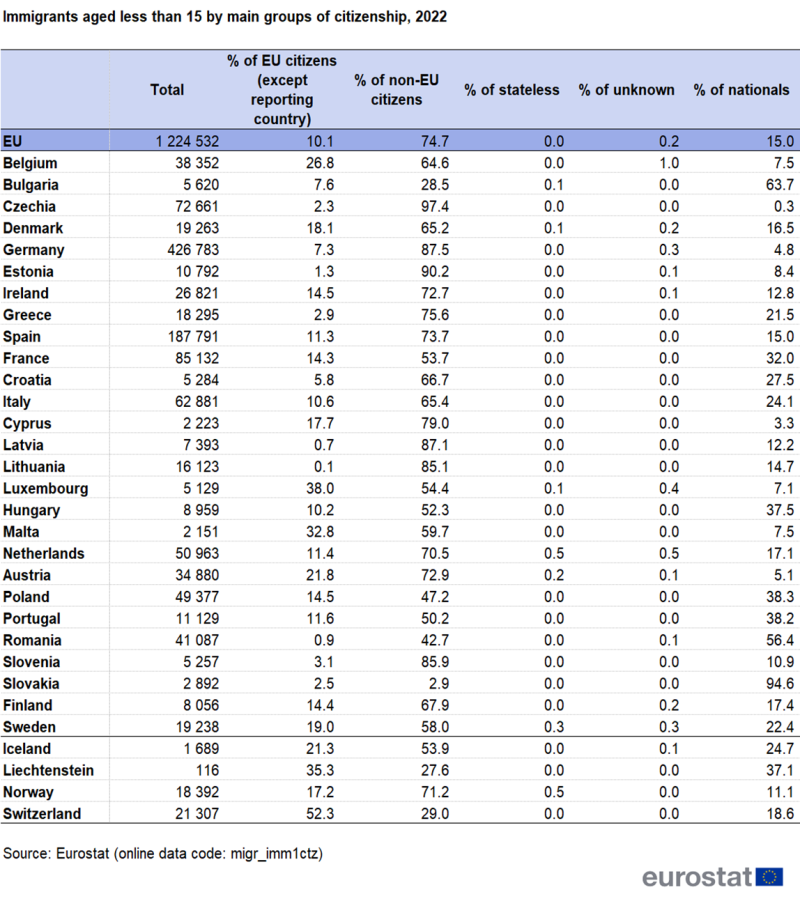
Source: Eurostat (migr_imm1ctz)
Figure 9 and Table 6 show the share of children aged less than 15 years in the total immigration in the EU by main group of citizenship. At EU level, the share of immigrant children is the highest for non-EU citizens and stateless then for nationals and the lowest for EU citizen children immigrating to an EU country different from their country of citizenship. It should also be noted that the share of children in the total immigration is not stable, particularly for non-EU citizen and stateless children and national children. For example, this share for non-EU citizen and stateless children was the highest during the migration crisis in 2015-2016, and recently in 2022. Whereas for national children the observed share followed an upward trend from 2014 to 2018 before slightly dropping in 2019 and in a more pronounced way in 2020 during the COVID-19 pandemic.
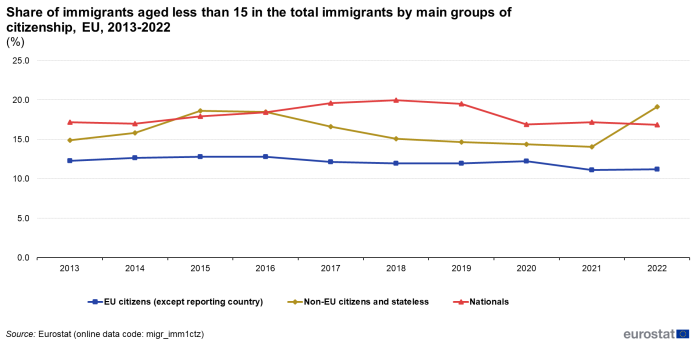
(%)
Source: Eurostat (migr_imm1ctz) and Eurostat (migr_pop1ctz)
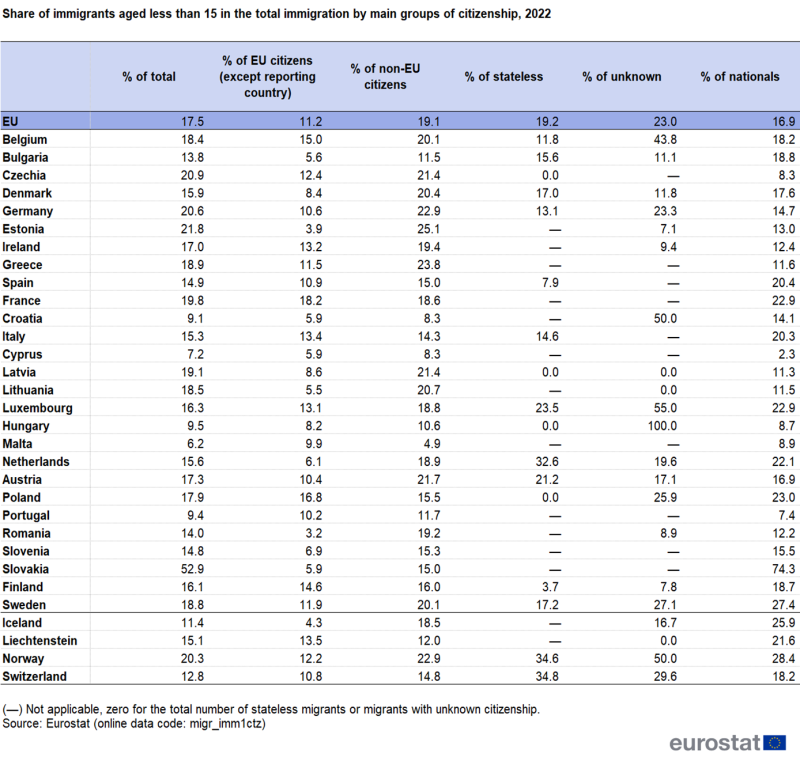
Source: Eurostat (migr_imm1ctz) and (migr_pop1ctz)
The highest share of children in the total immigration can be observed in Slovakia (52.9 %), ahead of Estonia (21.8 %). For Slovakia, it was caused by the share of children in the immigration of nationals, which equalled 74.3 %. The highest shares of EU citizen children were recorded in France (18.2 %), Poland (16.8 %), whereas the highest shares for non-EU citizen children were observed in Estonia (25.1 %) and Greece (23.8 %).
Live births by mother's citizenship
The number of births of non-national children is another factor influencing the share of non-national children in the total population of resident children. Table 7, which gives the number of live births by mother’s citizenship in 2022, provides an indicator to measure this phenomenon. In absolute terms, the number (169 320) of children born from an EU citizen mother living in an EU country different from her country of citizenship and the number (497 644) from a non-EU citizen mother (including stateless mothers). Even if not all new-born children automatically receive their mother's citizenship, this data highlights the importance of considering births in the analysis of child migration.
Table 7 also shows that at EU level, the yearly average growth rate of the total number of births (-1.1 %) was negative between 2013 and 2022, whereas it was positive for the number of live births recorded for foreign mothers with EU citizenship (+0.5 %) and non-EU citizenship (+2.5 %).
Acquisition of citizenship
Acquisition of citizenship by migrant children in their country of residence is another factor to consider when analysing children in migration. Table 8 shows the shares of children aged less than 15 years who acquired an EU country citizenship in the total number of acquisitions of citizenship, disaggregated by previous country of citizenship. In 2022, this share was equal to 19.5 % for children previously citizens of another EU country and 25.8 % for children previously citizens of a non-EU country.
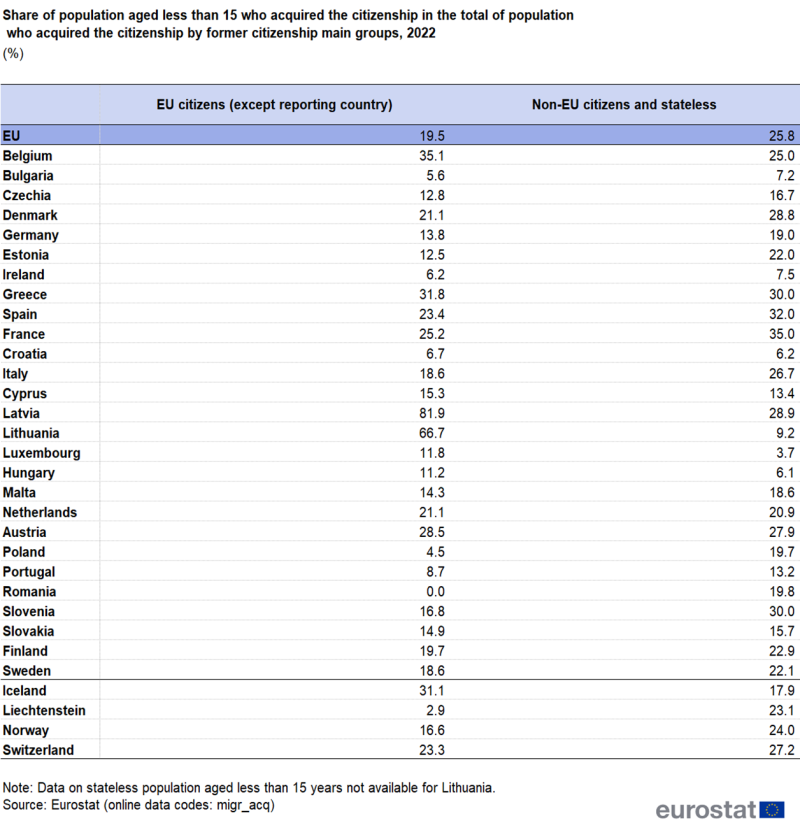
(%)
Source: Eurostat (migr_acq)
The share of children who acquired EU citizenship varies greatly from one country to another and over time. This share very much depends on the country’s policies on the acquisition of citizenship. In 2022, the share of children who acquired EU citizenship in the total of acquisitions of citizenship was higher than the EU average in ten EU countries, with the highest shares observed for Latvia (81.9 %) and Lithuania (66.7 %). The share of children previously citizens of a non-EU country was higher than the EU average in eight Member States, with the two highest shares recorded in France (35.0 %) and Spain (32.0 %).
Source data for tables and graphs
Data sources
This article presents European statistics on children in migration based on international migration flows, the number of national and non-national citizens in the population (stocks) as well as data relating to live births by mother's citizenship and the acquisition of citizenship. It focuses mainly on flows and stocks of foreign and stateless children broken down by EU and non-EU citizens. Data are collected on an annual basis and are supplied to Eurostat by the national statistical authorities of the EU and EFTA countries.
Legal sources
Since 2008, migration and international protection data have been collected based on Regulation (EC) No 862/2007. The analysis and composition of the EU, EFTA and candidate country groups as of 1 January of the reference year are given in Commission Regulation (EC) No 351/2010. This defines a core set of statistics on international migration flows, population stocks of foreigners, the acquisition of citizenship, residence permits, asylum and measures against illegal entry and stay. Although EU countries may continue to use any appropriate data sources according to national availability and practice, the statistics collected under the Regulation (EC) No 862/2007 must be based on common definitions and concepts. Most EU countries base their statistics on administrative data sources such as population registers, registers of foreigners, registers of residence or work permits, health insurance registers and tax registers. Some countries use mirror statistics, sample surveys or estimation methods to produce migration statistics. The implementation of the Regulation is expected to result in increased availability and comparability of migration statistics.
As stated in Article 2.1(a), (b), (c) of Regulation (EC) No 862/2007, immigrants who have been residing (or who are expected to reside) in the territory of an EU country for a period of at least 12 months are counted, as are emigrants living abroad for more than 12 months. Data collected by Eurostat therefore concern migration for a period of 12 months or longer: migrants therefore include people who have migrated for a period of one year or more as well as persons who have migrated on a permanent basis. Eurostat collects data on acquisitions of citizenship under the provisions of Article 3.1.(d) of Regulation (EC) No 862/2007, which states that 'Member States shall supply to the Commission (Eurostat) statistics on the numbers of (…) persons having their usual residence in the territory of the Member State and having acquired during the reference year the citizenship of the Member State (…) disaggregated by (…) the former citizenship of the persons concerned and by whether the person was formerly stateless'.
Methodological notes:
Age: Concerning the definitions of age for migration flows, please note that 2022 data concern the respondent's age reached or age at the end of the reference year for all EU countries with the exception of Estonia, Ireland, Greece, Malta, Austria, Romania and Slovenia. In these countries data concern the respondent's age completed or on their last birthday. On the definitions of age for acquisitions of citizenship, 2022 data concern the respondent's age reached or at the end of the reference year for all EU countries with the exception of Germany, Estonia, Greece, Ireland, France, Austria, Lithuania, Malta, Romania and Slovenia. In these countries, data concern the respondent's age completed or age on their last birthday. Other data are solely based on the age reached during the year.
Member States and EFTA countries by inclusion/exclusion of asylum seekers and refugees in the data on population reported to Eurostat in the framework of the Unified Demographic data collection Reference Year 2022
| Population as of 01.01.2023 | Included | Excluded |
|---|---|---|
| Asylum seekers usually resident for at least 12 months | Belgium, Czechia, Germany, Estonia, Ireland, Greece, Spain, France, Italy, Cyprus, Luxembourg, Malta, the Netherlands, Austria, Portugal, Norway, Switzerland | Bulgaria, Denmark, Croatia, Latvia, Lithuania, Hungary, Poland, Romania, Slovenia, Slovakia, Finland, Sweden, Iceland, Liechtenstein |
| Refugees usually resident for at least 12 months | Belgium, Bulgaria, Czechia, Denmark, Germany, Estonia, Ireland, Greece, Spain, France, Croatia, Italy, Cyprus, Latvia, Lithuania, Luxembourg, Hungary, Malta, the Netherlands, Austria, Poland, Portugal, Romania, Slovenia, Slovakia, Finland, Sweden, Iceland, Liechtenstein, Norway, Switzerland | |
| Refugees from Ukraine who benefit from temporary protection in the EU | Belgium, Czechia, Denmark, Germany, Estonia, Ireland, Greece, Spain, France, Croatia, Italy, Cyprus, Latvia, Lithuania, Luxembourg, Hungary, Malta, the Netherlands, Austria, Romania, Slovenia, Iceland, Norway, Switzerland | Bulgaria, Poland, Portugal, Slovakia, Finland, Sweden, Liechtenstein |
Member States and EFTA countries by inclusion/exclusion of asylum seekers and refugees in the data on migration reported to Eurostat in the framework of the Unified Demographic data collection Reference Year 2022
| Migration for 2022 | Included | Excluded |
|---|---|---|
| Asylum seekers usually resident for at least 12 months | Belgium, Czechia, Germany, Estonia, Ireland, Greece, Spain, France, Italy, Cyprus, Luxembourg, Malta, the Netherlands, Austria, Portugal, Norway, Switzerland | Bulgaria, Denmark, Croatia, Latvia, Lithuania, Hungary, Poland, Romania, Slovenia, Slovakia, Finland, Sweden, Iceland, Liechtenstein |
| Refugees usually resident for at least 12 months | Belgium, Bulgaria, Czechia, Denmark, Germany, Estonia, Ireland, Greece, Spain, France, Croatia, Italy, Cyprus, Latvia, Lithuania, Luxembourg, Hungary, Malta, the Netherlands, Austria, Poland, Portugal, Romania, Slovenia, Slovakia, Finland, Sweden, Iceland, Liechtenstein, Norway, Switzerland | |
| Refugees from Ukraine who benefit from temporary protection in the EU (¹) | Belgium, Czechia, Denmark, Germany, Estonia, Ireland, Greece, Spain, France, Croatia, Italy, Cyprus, Latvia, Lithuania, Luxembourg, Hungary, Malta, the Netherlands, Austria, Romania, Slovenia, Iceland, Norway, Switzerland | Bulgaria, Poland, Portugal, Slovakia, Finland, Sweden, Liechtenstein |
(¹) On 2 March 2022, the Commission activated the Temporary Protection Directive to offer quick and effective assistance to people fleeing the war in Ukraine. Under this proposal, those fleeing the war will be granted temporary protection in the EU, meaning that they will be given a residence permit, and they will have access to education and to the labour market. See Context for additional information.
Refugee: The term does not solely refer to persons granted refugee status (as defined in Art.2(e) of Directive 2011/95/EC within the meaning of Art.1 of the Geneva Convention relating to the Status of Refugees of 28 July 1951, as amended by the New York Protocol of 31 January 1967) but also to persons granted subsidiary protection (as defined in Art.2(g) of Directive 2011/95/EC) and persons covered by a decision granting authorisation to stay for humanitarian reasons under national laws concerning international protection.
Asylum seeker: First-time asylum applications are country-specific and imply no time limit. Therefore, an asylum seeker can apply for the first time in a given country and afterwards again as first-time applicant in any other country. If an asylum seeker lodges once more an application in the same country after any period of time, (s)he is not considered again a first-time applicant.
Following Eurostat’s recommendations to ensure consistency of statistics over time, several Member States (Bulgaria, Germany, Ireland, Greece, Spain, France, Croatia, Italy, Cyprus, Lithuania, Hungary, Malta, Poland, Portugal, Norway) have revised or are in process of revising their population or migration time series between the reference years of the population and housing censuses held in 2011 and 2021.
Guidance on the inclusion of refugees from Ukraine who benefit from temporary protection in the EU in the usually resident population: persons from Ukraine granted temporary protection should be counted as part of the usually resident population. Based on this, those who arrived from Ukraine and were granted temporary protection during the year – and who are believed to still be present at the end of the year – should be counted as immigrants during the year and as part of the migrant stock at the end of the reference period.
For the purpose of this Statistics Explained, the distinction between EU and non-EU citizens for the stocks of migrants and immigration flows is based on the composition in force at the time of reference of data. Therefore, for non-EU child migrants, citizens from the United Kingdom are counted as EU citizens from 1 January 2013 to 1 January 2020 while they are counted as non-EU citizens in 2021, 2022 and 2023 data. For immigration flows, citizens from the United Kingdom are counted as EU citizens from 2013 to 2020 while they are counted as non-EU citizens in 2021 and 2022. This break in the presented time series implies that the data from 2021 onwards are not fully comparable with the data prior to 2021.
Non-national category includes the following categories: EU citizens (excluding the reporting country), non-EU citizens, stateless and unknown.
Context: EU migration policy
In recent years, the number of children in migration[1] arriving in the European Union, many of whom are unaccompanied, has increased in a dramatic way, particularly due to migration crisis in 2015-2016, and recently in 2022 due to the war in Ukraine.
Protecting children is first and foremost about upholding European values of respect for human rights, dignity and solidarity. This is why protecting all children in migration, regardless of status and at all stages of migration, is a priority. The European Union, together with its Member States and with the support of the relevant EU agencies (European Border and Coast Guard Agency; European Union Agency for Asylum (EUAA) and the European Union Agency for Fundamental Rights (FRA)), has been active on this front for many years. The existing EU policies and legislation provide a solid framework for the protection of the rights of the child in migration covering all aspects including reception conditions, the treatment of their applications and integration.
The protection of children in migration starts by addressing the root causes which lead so many of them to embark on perilous journeys to Europe. This means addressing the persistence of violent and often protracted conflicts, forced displacement, inequalities in living standards, limited economic opportunities and access to basic services by making sustained efforts to eradicate poverty and deprivation and develop integrated child protection systems in non-EU countries. The European Union and its Member States have stepped up their efforts to establish a comprehensive external policy framework to reinforce cooperation with partner countries in mainstreaming child protection at the global, regional and bilateral level. The European Union is fully committed to implement the 2030 Agenda for Sustainable Development, which calls for a world in which every child grows up free from violence and exploitation, has his/her rights protected and access to quality education and healthcare. The 2015 Valletta Summit[2] political declaration and its Action Plan calls for the prevention of and fight against irregular migration, migrant smuggling and trafficking in human beings (with a specific focus on women and children).
The EU Guidelines on the Promotion and Protection of the Rights of the Child renew the EU's commitment to promote and protect the indivisibility of the rights of the child in its relations with non-EU countries, including countries of origin or transit. In this context, the Council reaffirmed the need to protect all refugee and migrant children, regardless of their status, and give primary consideration at all times to the best interests of the child, including unaccompanied children and those separated from their families, in full compliance with the UN Convention on the Rights of the Child and its Optional Protocols.
Within the European Commission, the Directorate-General for Migration and Home Affairs is responsible for immigration policy, whereas the Directorate-General for Justice and Consumers is in charge of child policy. All relevant legal acts and information regarding the EU's immigration policy can be accessed on the European Commission's website. Readers interested in the recent development of the global immigration policy in the European Union are also invited to refer to the New Pact on Migration and Asylum which has been presented by the European Commission in September 2020 and adopted by the European Parliament in April 2024, and by the Council of the EU in May 2024.
The New pact on Migration and Asylum underlines that the EU asylum and migration management system needs to provide for the special needs of vulnerable groups, including children. In particular, the reform of EU rules on asylum and return is an opportunity to strengthen safeguards and protection standards under EU law for migrant children with the following goals:
- The right for the child to be heard in the context of asylum and migration proceedings.
- Unaccompanied minors should be appointed a guardian within 15 working days.
- Unaccompanied minors and families with children under 12 years to be exempted from the mandatory border procedure.
- Develop effective alternatives to detention for children and their families.
- Rules on evidence required for family reunification simplified.
- The right to adequate accommodation and assistance, prompt and non-discriminatory access to education, and early access to integration services, will be reinforced.
Direct access to
Methodology
- Population (national level) (ESMS metadata file — demo_pop_esms)
- International Migration statistics (ESMS metadata file — migr_immi_esms)
- Acquisition and loss of citizenship (ESMS metadata file — migr_acqn_esms)
- DG for Migration and Home Affairs — Legal migration and Integration
- DG Justice and Consumers — Policies
- DG for Employment, Social Affairs & Inclusion — European Child Guarantee
- The EU Strategy on the Rights of the Child and the European Child Guarantee
- New Pact on Migration and Asylum
- JRC Publications Repository — Data on Children in Migration
- International Data Alliance for Children on the Move (IDAC)
Notes
- ↑ The terms 'children in migration' or 'children' in this document cover all non-EU country national children (persons below 18 years old) who are forcibly displaced or migrate to and within the EU territory, be it with their (extended) family, with a non-family member (separated children) or alone, whether or not seeking asylum.
- ↑ https://www.consilium.europa.eu/media/21839/action_plan_en.pdf
